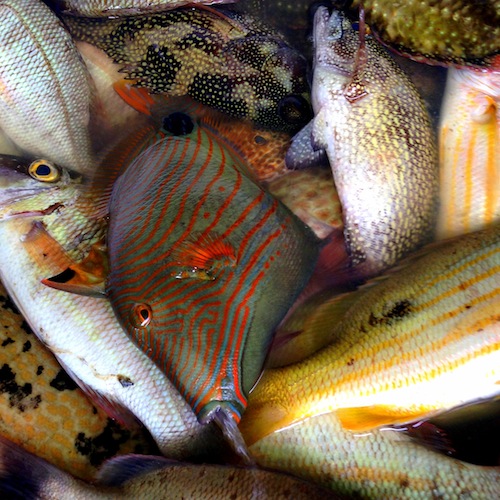By Alex Frost and Kim Burnett
Two UHERO graduate researchers, Alex Frost and Cheryl Scarton, attended a field course about social-ecological resilience of island systems in Nadave, Fiji. Participants of the field course were students and environmental practitioners from places throughout the Pacifc like Fiji, Vanuatu, Micronesia and the Solomon Islands.
On day three of the field course, the group took an early morning boat ride to Viwa, an island community of 30 households that is largely food and water self-sufficient. The home stay experience immersed participants in a traditional village lifestyle to apply terrestrial and marine survey methodologies learned from previous days.

Based on western standards and traditional economic measure like income, labor, and production, Viwa would be considered impoverished. The residents’ primary income is through selling excess fish and crops at the market and organization of a home stay immersion program. The island has intermittent power at night from a diesel generator, water comes from a thoughtfully engineered catchment system, and the intermittent power limits access to television and Internet.
From a lens that focuses on social and natural capital versus human and financial capital, Viwa is ecologically and socially wealthy. There is strong community cohesion – every Monday is a rotating social work day, where residents take the time to help one family plant, weed or harvest. Everybody shares excess harvest and people have time for leisure and storytelling. They are always joking, laughing and singing. The knowledge of agroforestry and management of fisheries is passed down through observation and application between generations that do not harm the health of the soil and encourages biodiversity, both are key indicators of sustainability.
How resilient is Viwa island? The common definition of resilience is “the capacity of a system to absorb disturbances or shocks and adapt accordingly while still retaining the same function and structure (McClanahan et al. 2012).” Economically speaking, global financial collapse will probably not affect Viwa at all, but the increasing demand of marine resources from Asia is pressuring people to over harvest. Ecologically, it seems the biggest challenge is invasive species, but heterogeneity of the agroforestry system minimizes the spread of pests and disease, compared to monoculture agriculture. Additionally, they have social mechanisms in place to prepare for extreme events like hurricanes. The island is especially vulnerable to sea level rise, coral bleaching, and shifts in weather patterns (such as a long drought). The village residents are working to develop an extensive water infrastructure system in the future to connect water pipes with an adjacent island. Still, the village faces many social challenges. Younger generations are adapting to the expectations of the market economy by working off island, which leads to a loss of traditional ecological knowledge. Concurrently the growing island population requires further clearing of the land for more housing.
Overall, the week-long intensive field course brought together faculty, students, and experts to disseminate and learn various methods and tools to measure social-ecological resilience. The forum encouraged network building between the University of Hawai’i and University of South Pacific. The variety of perspectives helped increase participant capacity to challenge existing mental models and assumptions. The experience inspired students to develop future interdisciplinary research on island resilience and identify opportunities to mitigate complex challenges that face Pacific nations, like the impacts of climate change.
BLOG POSTS ARE PRELIMINARY MATERIALS CIRCULATED TO STIMULATE DISCUSSION AND CRITICAL COMMENT. THE VIEWS EXPRESSED ARE THOSE OF THE INDIVIDUAL AUTHORS. WHILE BLOG POSTS BENEFIT FROM ACTIVE UHERO DISCUSSION, THEY HAVE NOT UNDERGONE FORMAL ACADEMIC PEER REVIEW.